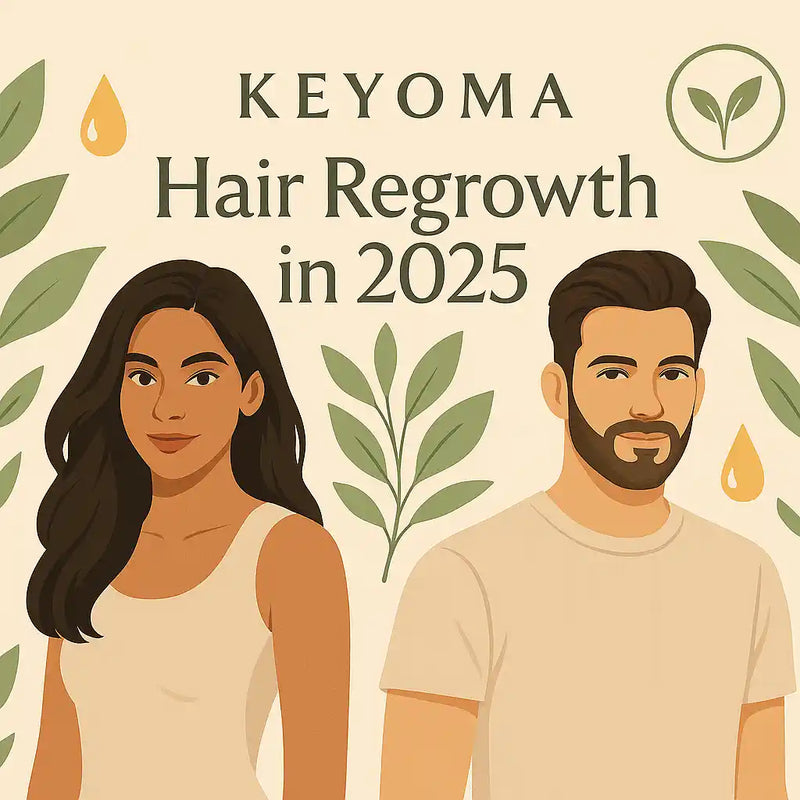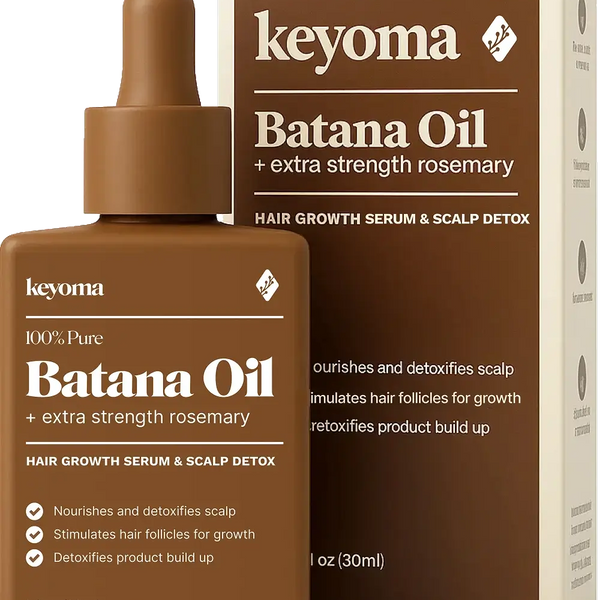In this article
Hair loss affects millions, and in 2025, more people are searching for safe , effective, and accessible ways to deal with it. From updated medications to clean oils and at-home laser tools, the choices have expanded fast.
If your hair has started feeling thinner, that is not something to ignore. And you are definitely not the only one going through it.
This guide walks through the top treatments people are talking about right now, so you can figure out what makes the most sense for your hair, your routine, and your comfort level.
Why Hair Regrowth Is a Hot Topic in 2025
Hair regrowth is top of mind for more people in 2025. You see the signs—more hair in the drain, thinner spots at the crown—and it is harder to ignore. Some are dealing with stress , others with hormonal shifts or postpartum recovery . But the result is the same: hair loss that feels frustrating and sometimes out of your control.
You have likely tried a product or two already. Maybe they burned your scalp. Maybe they promised too much and delivered nothing.
That is why more people are turning to cleaner , more natural, and evidence-based treatments. They want real results without the sting of synthetic ingredients. And brands are finally starting to listen.
Main Hair Regrowth Categories to Know

Before you spend money on a product or commit to a routine, it helps to know what types of treatments are out there. Most hair regrowth methods fall into five main groups. You have FDA-approved medications , natural oils , supplements , laser tools , and in-clinic therapies .
Each option works in a different way depending on what is behind your hair loss. Some people respond better to topicals. Others might need internal support or clinical help.
Knowing the categories makes it easier to focus your time, energy, and budget where it matters.
FDA-Approved Treatments

If you ask most doctors where to begin, they will likely mention FDA-approved treatments first. These options have been studied for years, and they continue to lead the way in hair regrowth because they are accessible, predictable, and often effective.
In 2025, the top three FDA-approved choices include:
- Minoxidil: This is a foam or liquid you apply directly to the scalp. It works by improving blood flow to the follicles.
- Finasteride: Taken orally or applied topically, this medication lowers DHT, a hormone tied to male and female pattern baldness.
- Ritlecitinib:. This newer option is designed for autoimmune conditions like alopecia areata.
These treatments are especially helpful if your hair loss is caused by hormones or genetics. If you are looking for something medically backed and easy to find, this is a strong place to begin.
Natural Ingredients and Oils

More people in 2025 are choosing natural oils and plant-based remedies to deal with hair loss. And it is not hard to see why. These options are known for being gentle on the scalp while still offering real support for regrowth.
Some oils getting the most attention right now include:
- Rosemary oil, which boosts circulation and has been compared to minoxidil in some studies.
- Batana oil, a traditional ingredient in Central American beauty routines that helps with moisture and follicle strength.
- Castor oil, rich in ricinoleic acid, which can support scalp balance.
- Ayurvedic blends, often made with amla, bhringraj, and fenugreek to help strengthen hair naturally.
These oils are not overnight fixes, but they do work best with consistent use and light scalp massage. If your scalp tends to react to conventional products, this path might feel a lot better to stick with.
Supplements and Nutrition

Supplements are playing a bigger role in hair regrowth in 2025. People are taking a step back and checking their vitamin levels , diet , and stress load before investing in products for their scalp. It makes sense. If your body is not getting what it needs, your hair will show it.
Some of the most talked-about supplements include biotin , which helps with keratin production, and vitamin D , since low levels are often tied to shedding. Iron is important too, especially for women with thinning hair. And collagen supports your scalp health from the inside out. A lot of people also rely on zinc to balance oil production and help with repair.
But here is the thing. These are not magic pills. They work best when you build them into a full plan that includes good food, regular routines, and some patience. No serum can fix what your body is missing.
Laser and Light Devices

If medications or injections are not your thing, laser therapy could be something to consider. These tools use low-level light therapy (LLLT) to boost blood flow and wake up hair follicles. And the best part? You do not need to apply any messy product.
Here are a few home-use options people are trying in 2025:
- Laser combs are compact and easy to use, plus they are often the cheapest way to get started.
- Laser helmets give full coverage and work well for people who want hands-free sessions.
- Laser caps slip under a regular hat, so you can wear them while doing other things around the house.
Most of these devices are painless and take just a few sessions each week. If you like tech and want something low-effort, laser tools might fit easily into your routine.
In-Clinic Treatments and Injections
Sometimes, home treatments are not enough. In-clinic options offer a different level of care, especially for people dealing with serious or long-term hair loss.
Clinics and dermatology centers now offer several advanced treatments. PRP (Platelet-Rich Plasma) is one of the most common. It uses your own blood plasma to help awaken dormant follicles. Peptide injections deliver amino acids straight to the scalp, where they support growth and repair. Some are trying stem cell therapy , which is still experimental but gaining interest for its potential to restore thinning areas. And microneedling with growth factors is being used to boost collagen and improve how well topicals work.
These are not cheap fixes, and they often take a few sessions to see real changes. But if you have tried everything else without success, this could be a step worth exploring.
What’s Trending in 2025 Hair Regrowth
Hair regrowth is not just about picking one product and hoping for the best. People want something that fits their goals , their routine , and what they can actually stick with day to day. In 2025, more are combining proven ingredients , ancestral oils , and small daily habits that add up over time.
And honestly, it can feel like a lot to sort through . That is why this next section breaks down the strategies people are actually using—and staying consistent with.
Multi-Peptide Serums
Multi-peptide serums are getting a lot of attention in 2025, and for good reason. They help tackle different causes of hair thinning without the harsh effects that come with some other products. These formulas are usually lightweight and packed with amino acids , hydrating agents , and peptides that support growth .
People like them because they are simple to use. No heavy buildup. No strong smell. And they layer well with other treatments you may already be using.
If you want something easy, clean, and backed by solid ingredients, this is a great place to start.
Clean, Ancestral Oils
Clean, ancestral oils are having a moment in 2025. They bring together heritage practices, simple ingredients , and real results without the chemical overload. These oils have been part of cultural beauty rituals for generations, and now more people are turning to them as a natural way to care for their scalp.
They are especially helpful if you have a sensitive scalp, are recovering from postpartum hair changes, or want to avoid synthetic formulas altogether. Some come as single-ingredient oils. Others are blended using traditional recipes passed down through families.
If you are drawn to remedies that feel both effective and meaningful, these oils could be exactly what your routine is missing.
Combination Therapies
More people are turning to combination therapies in 2025 because they want a more complete and flexible approach to hair regrowth. Rather than sticking with one method, they are mixing topicals , supplements , and devices to support different angles of hair health at once.
Here is what that might look like in practice. Someone might apply minoxidil in the morning and follow it up with rosemary oil at night. Another person could take biotin or collagen supplements while using a laser cap a few times a week. Some also combine scalp massage with PRP treatments or microneedling to boost absorption and blood flow.
The reason this trend is growing is simple. It meets people where they are. If one thing did not work on its own, blending treatments could be what finally moves the needle.
How to Choose the Right Hair Regrowth Treatment

There is no one-size-fits-all answer when it comes to hair regrowth. The best treatment depends on what is causing the hair loss and how far it has progressed. You need to match the solution to your specific situation.
If your hair loss is genetic , minoxidil or finasteride are often the first place to look. These are widely studied and tend to work best for pattern baldness.
Hair thinning from pregnancy or hormonal changes ? A clean oil like Batana or rosemary is a gentler choice that supports regrowth without interfering with your hormone balance.
A scalp that feels itchy, inflamed, or irritated likely needs something soothing. You can skip harsh formulas and try oils that calm the skin. And it would not hurt to take a look at your diet. Sometimes things like dairy or processed foods can make it worse.
If the hair loss came on fast and is tied to stress or illness , your body might be short on key nutrients. Biotin, iron, and vitamin D are good places to start to help stabilize growth.
And if you have already tried more than one thing without seeing results, it may be time to look into laser devices or visit a clinic for PRP or peptide treatments.
You have to know your body, your triggers, and how much time and energy you can give this. The right treatment is not the most expensive. It is the one you will stick with.
Best First Steps If You’re New to Hair Loss Solutions
It is easy to feel overwhelmed when you are just starting out with hair regrowth. But it does not have to be complicated. The smartest way to begin is with simple, low-risk steps that support your scalp and give your hair a healthy base to grow.
Start with a clean oil like Batana or rosemary. They are both gentle, especially if your scalp feels sensitive or reactive. Then add a supplement that includes biotin , iron , or collagen to support growth from the inside. A soft-bristle brush or daily scalp massage can help boost circulation too.
Give it time. Try sticking to your routine for at least 90 days. Take photos every few weeks and look out for changes in texture, fullness, or shedding. You do not need to do it all at once. Staying consistent matters more than having the perfect lineup.
When you are ready to begin, try Keyoma’s clean, ancestral oils. No harsh chemicals. No gimmicks. Just real care for your hair.
Featured Product
100% Pure Batana Oil + Rosemary









